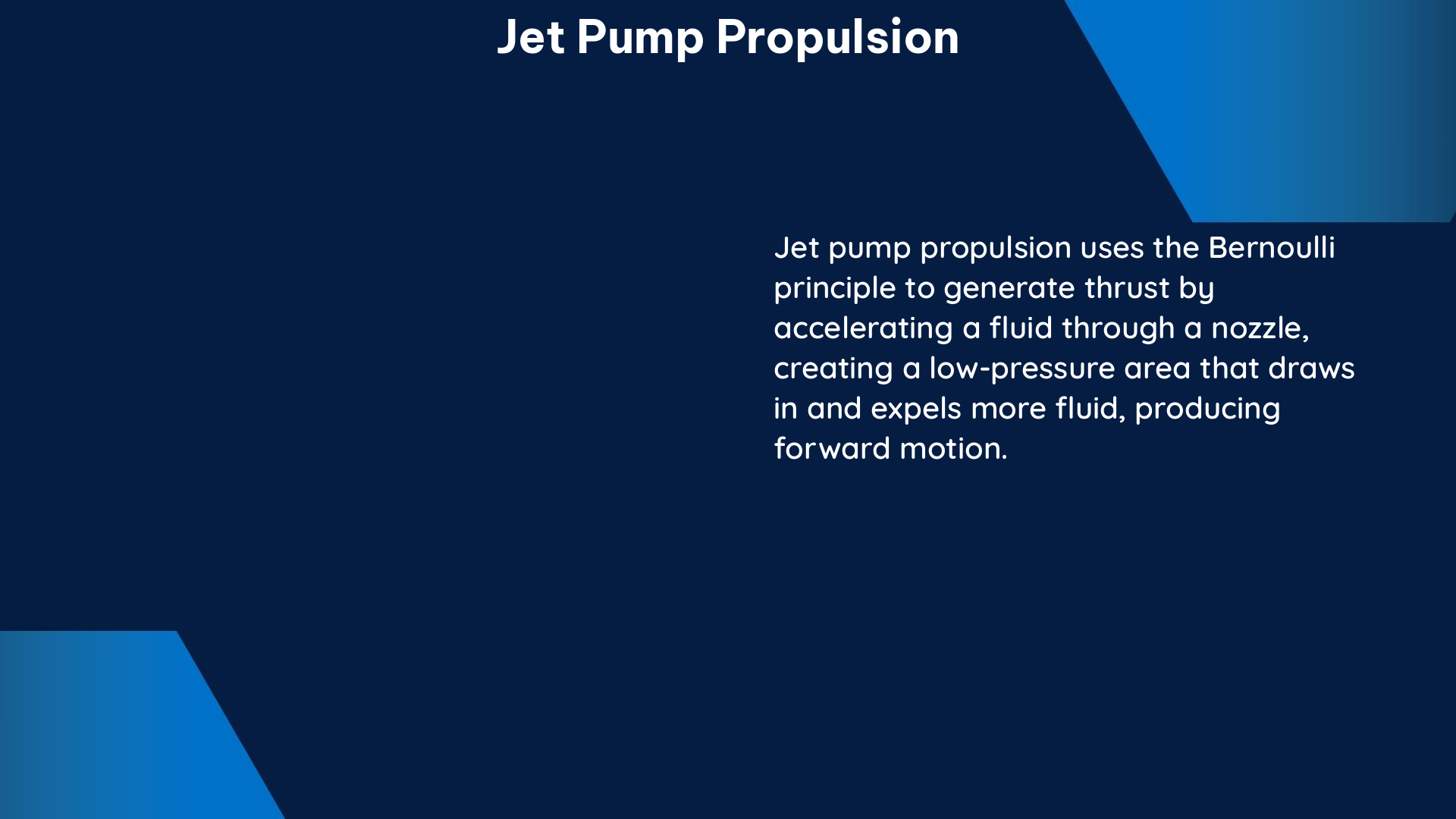Jet pump propulsion is a highly efficient and versatile propulsion system that utilizes a high-velocity jet of fluid to generate thrust. This technology is widely employed in underwater vehicles, such as submarines and autonomous underwater vehicles (AUVs), as well as in high-performance watercraft, offering superior maneuverability and speed. In this comprehensive guide, we will delve into the intricacies of jet pump propulsion, exploring the design, performance, and practical considerations for DIY implementation.
Understanding the Pump-Jet: The Heart of Jet Pump Propulsion
The key component of a jet pump propulsion system is the pump-jet, which is responsible for generating the high-velocity jet of fluid. According to a review article on the hydrodynamic performance and design of pump-jets, the pump-jet typically consists of a rotating impeller and a diffuser, enclosed within a housing.
Impeller Design and Performance
The impeller is the driving force behind the jet pump, responsible for accelerating the fluid. The size, shape, and rotational speed of the impeller are critical factors that influence the pump-jet’s performance. Factors such as blade geometry, number of blades, and tip clearance can significantly impact the impeller’s efficiency and the overall thrust generated by the system.
| Impeller Characteristic | Typical Range |
|---|---|
| Diameter | 0.1 – 1.0 meters |
| Rotational Speed | 1,000 – 10,000 RPM |
| Blade Tip Velocity | 50 – 300 m/s |
| Number of Blades | 5 – 15 |
Diffuser Design and Performance
The diffuser, on the other hand, is responsible for slowing down the high-velocity fluid and increasing its pressure. The design of the diffuser, including its shape, length, and angle, can significantly impact the overall efficiency of the pump-jet. A well-designed diffuser can help to minimize energy losses and optimize the thrust output.
| Diffuser Characteristic | Typical Range |
|---|---|
| Diameter Ratio (Outlet/Inlet) | 1.2 – 2.0 |
| Diffuser Angle | 5 – 15 degrees |
| Diffuser Length | 0.5 – 2.0 times the inlet diameter |
Hydrodynamic Performance Factors
The hydrodynamic performance of the pump-jet is influenced by various factors, including the size and shape of the impeller and diffuser, the clearance between the impeller and the housing, and the properties of the fluid being pumped. A study on the driving force characteristics in the formation of dominant vortices in water jet propulsion pumps found that the spatial evolution characteristics of pressure fluctuation and rigid vorticity in the pump-jet are closely related to the overall performance of the pump.
Technical Specifications and Applications

The size and power of a jet pump propulsion system can vary widely depending on the specific application. For example, a high-performance watercraft may utilize a jet pump propulsion system with an input power of several hundred horsepower and a jet velocity of over 100 meters per second. In contrast, an AUV may employ a jet pump propulsion system with an input power of only a few kilowatts and a jet velocity of around 10 meters per second.
High-Performance Watercraft
- Input Power: 200 – 500 horsepower
- Jet Velocity: 100 – 150 m/s
- Thrust: 2,000 – 5,000 Newtons
Autonomous Underwater Vehicles (AUVs)
- Input Power: 2 – 10 kilowatts
- Jet Velocity: 5 – 15 m/s
- Thrust: 50 – 500 Newtons
DIY Jet Pump Propulsion: Practical Considerations
For those interested in building their own jet pump propulsion system, there are various DIY resources available online. One such resource, the “How to Build a Jet Pump: DIY Instructions” on Instructables, provides detailed instructions on constructing a small jet pump using a water pump, a nozzle, and a propeller.
However, it is important to note that building a jet pump propulsion system requires a deep understanding of the underlying principles and technical specifications, as well as access to the necessary tools and materials. Some key considerations for DIY jet pump propulsion include:
- Impeller and Diffuser Design: Carefully designing the impeller and diffuser to optimize efficiency and thrust output is crucial. This may involve 3D printing or custom fabrication of these components.
- Fluid Dynamics Calculations: Accurately modeling the fluid flow, pressure, and velocity within the pump-jet is essential for predicting and optimizing performance.
- Structural Integrity: Ensuring the structural integrity of the housing and other components to withstand the high pressures and forces generated by the jet pump.
- Power and Control Systems: Integrating the appropriate power source, motor, and control systems to precisely regulate the jet pump’s operation.
By addressing these technical considerations and leveraging available resources, DIY enthusiasts can embark on the exciting journey of building their own jet pump propulsion systems, unlocking the potential for innovative applications and personal exploration.
References:
- A Review on Hydrodynamic Performance and Design of Pump-Jet: Advances, Challenges, and Prospects. (n.d.). ResearchGate. Retrieved June 6, 2024, from https://www.researchgate.net/publication/364468947_A_Review_on_Hydrodynamic_Performance_and_Design_of_Pump-Jet_Advances_Challenges_and_Prospects
- Elucidated the Spatial Evolution Characteristics of Pressure Fluctuation and Rigid Vorticity in Water Jet Propulsion Pumps. (2023, December 1). ScienceDirect. Retrieved June 6, 2024, from https://www.sciencedirect.com/science/article/abs/pii/S0029801823026756
- On Certain Problems of Water Jet Propulsion. (n.d.). Defense Technical Information Center. Retrieved June 6, 2024, from https://apps.dtic.mil/sti/trecms/pdf/AD0630685.pdf
- A Review on Hydrodynamic Performance and Design of Pump-Jet. (n.d.). MDPI. Retrieved June 6, 2024, from https://www.mdpi.com/1889606
- Analysis of the Impeller’s Tip Clearance Size on the Operating Characteristics of the Underwater Vehicle with a New High-Speed Water Jet Propulsion Pump. (2021, September 15). ResearchGate. Retrieved June 6, 2024, from https://www.researchgate.net/publication/357885629_Analysis_of_the_Impeller’s_Tip_Clearance_Size_on_the_Operating_Characteristics_of_the_Underwater_Vehicle_with_a_New_High-Speed_Water_Jet_Propulsion_Pump
- How to Build a Jet Pump: DIY Instructions. (n.d.). Instructables. Retrieved June 6, 2024, from https://www.instructables.com/Jet-Pump/

The lambdageeks.com Core SME Team is a group of experienced subject matter experts from diverse scientific and technical fields including Physics, Chemistry, Technology,Electronics & Electrical Engineering, Automotive, Mechanical Engineering. Our team collaborates to create high-quality, well-researched articles on a wide range of science and technology topics for the lambdageeks.com website.
All Our Senior SME are having more than 7 Years of experience in the respective fields . They are either Working Industry Professionals or assocaited With different Universities. Refer Our Authors Page to get to know About our Core SMEs.